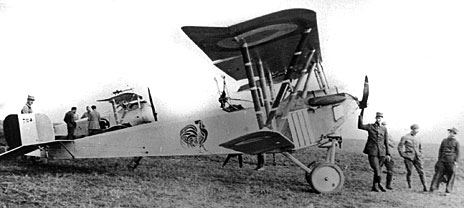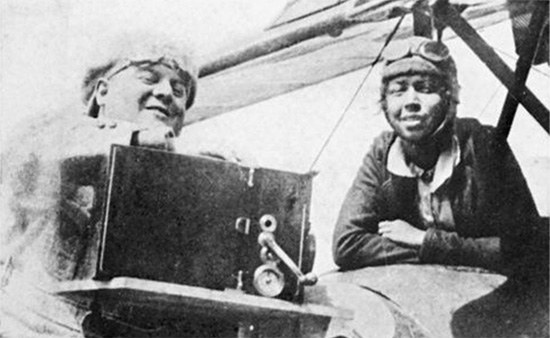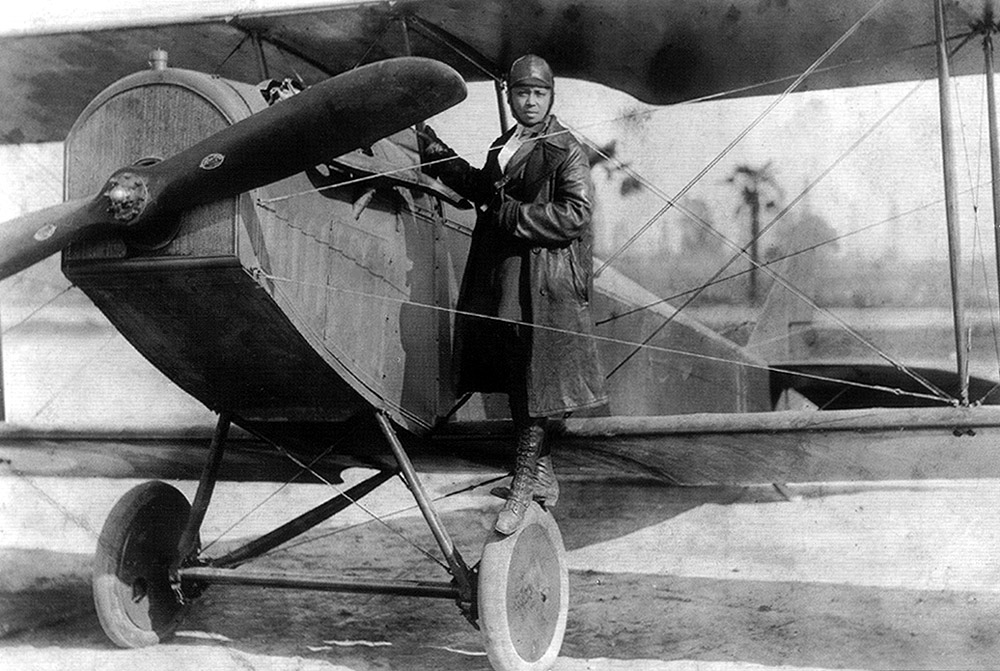We’re so excited to have author and FYA fave Elizabeth Wein (Code Name Verity, Rose Under Fire, and Black Dove, White Raven) sharing the history behind her latest plane-flying heroine: real-life aviatrix Bessie Coleman. Take it away, Elizabeth!
Born in a dirt-floored sharecropper’s shack in Texas, Bessie Coleman wasn’t just the first black woman to get a pilot’s license; she was the first American, black or white, male or female, to earn an International Pilot’s License from the Fédération Aéronautique Internationale.

Biographical Details
Name says: A fine English name: there’s no more royal name than Elizabeth (says me). Indeed Bessie Coleman was known in her lifetime as “Queen Bess” and “Brave Bess.” However, as happened to so many African-Americans, the prosaic English (or possibly Irish) family name “Coleman” may have originated with slaveowners.
Date of Birth/Death: January 26, 1892 – April 30, 1926 (32 years old)
Era says: Bessie is more or less of the same generation as so many famous early aviators: Amelia Earhart (born 1897), Howard Hughes (1905), Charles Lindbergh (1902), and Antoine de St. Exupéry (1900), to name a few you’ve probably heard of. Indeed, Bessie was born in the same year as Baron Manfred von Richthoven, aka the Red Baron. While Bessie was growing up the world was wiring itself for the twentieth century, plunged into World War, and about to enter the Jazz Age.
Place of Birth: Atlanta, Cass County, Texas
Place of birth says: Times are changing…
Atlanta, Texas had only been around for about 20 years when Bessie was born there. But despite the national depression it was in its heyday: it was on the Texas and Pacific Railroad and there was a boom in lumber. In 1890 Atlanta had a population of not-quite 2000, including both blacks and whites. Bessie’s father, George Coleman, had three Native American grandparents; her mother, Susan Coleman, came from Georgia and was probably the daughter of former slaves. They were illiterate sharecroppers but foresaw a better life for their children. George bought land and built a house in Waxahachie, Texas when Bessie was two. She attended school (segregated, of course) from the age of 6.
Circumstantial Evidence
Where She’s Been:
Texas: So, her father George got fed up with Texas. He had Native American as well as African-American heritage and was beset with prejudice and discrimination from all sides. In 1901 he decided to move to Oklahoma, where he could be in Indian Territory, but Bessie’s mother Susan didn’t share George’s background and didn’t want to go. She stayed in Texas as a single parent to four small girls, of which Bessie was one (Bessie’s nine older siblings had already left home).
Oklahoma: Bessie completed the eight grades offered by the Waxahachie School, worked her butt off as a laundress for five years, and spent her entire savings on a single term enrolled in the Colored Agricultural and Normal University in Langston, OK. She could see that education might be her ticket to a better life.
Back in Texas. More laundry. Another five years of other people’s laundry. Bessie begged her older brother Walter to let her come live with him in…
CHICAGO! Chicago was the place to be if you were young, black, and ambitious in the nineteen-teens. Bessie found work as a manicurist. Eventually a taunting conversation with another older brother, John—who’d been to France and seen women flying there—goaded Bessie toward aviation.
France: Nobody in Chicago would teach Bessie to fly.
Nobody of any color in Chicago would teach Bessie to fly: no one would teach a black woman to fly.
Bessie had some impressive connections by now, though, because she did manicures for all Chicago’s black society. She contacted Robert Abbott, the editor and publisher of the Chicago Defender, with a proposition. She’d learn to speak French if he’d sponsor her to go to France to learn to fly. Win-win — a great story and PR for Chicago’s black newspaper, and Bessie would finally leave the ground. Abbott, along with Chicago banker Jesse Binga, gave her the financial backing to go to France.
So much of success is grounded in persistence and paperwork. Having arranged the money, Bessie followed through with the French lessons, applied for a passport, got the necessary visas and made the long ocean voyage, arriving in Europe in November 1920. Again, the first French flight school she applied to would not take women. With characteristic aplomb she then successfully applied to France’s best known flight school, L’École d’Aviation des Frères Caudron. She learned to fly in a typical French trainer, the Nieuport Type 82 (the training version of a Nieuport 14).

Her biographer, Doris L. Rich, reports that Bessie walked nine miles to the airfield and back to her room every day for ten months while on the course.
Bessie received her license on 15 June 1921, and spent the next two months honing her aviation skills. She knew she’d need to be a performer if she was going to make any money; flying shows, sponsored record-breaking, and air races were bread and butter to the aviation pioneers of the early twentieth century.
Bessie returned to the US for about six months and was showered with accolades for her achievement, but quickly realized that not only didn’t she have a plane, she still wasn’t competitive as a pilot. So in February 1922 she went back to Europe for MORE training.
A citizen of Europe: After another two-month course in Paris practicing aerobatics, Bessie visited the Fokker aircraft workshop in Holland, where she was fêted by Anthony Fokker, her contemporary and one of the top aircraft designers of the day. She then travelled on to Berlin in Germany, where she met and charmed a host of World War I aerial aces, and got Pathé to film her flying over the former Kaiser’s palace.

What She’s Done:
Become Queen of the Air: On Sunday, October 15, 1922, Bessie got to perform her own air show at Checkerboard Airdrome in Chicago. The Defender ran a great publicity campaign, calling her “The Race’s only aviatrix”; admission to the show was hefty, at $1 for adults (about $14 in today’s money). Bessie attracted an audience of two thousand people, both black and white. In a borrowed plane she performed four exhibition flights and then gave joy rides until after dark. It was a seriously triumphant homecoming.
Get a Film Deal: Bessie actually signed a contract to star in a feature film (eight whole reels!) made about her own life. It would be titled Shadow and Sunshine and was to be produced by the African American Seminole Film Producing Company. Bessie quit three weeks after signing, when the filmmakers informed her “she would have to appear in the first scene dressed in tattered clothing and with a walking stick and a pack on her back” to represent her sharecropper’s upbringing. “‘No Uncle Tom stuff for me!’ was her parting shot” to the production company (quoted in Rich, p 57)
But Bessie did have two reels’ worth of Pathé footage of herself in the air, and she used it to great advantage, travelling to schools and civic clubs and giving lectures on aviation which included showing the films to local audiences.
Buy Her Own Planes:

It was really hard having to depend on other people to lend you planes for flying shows. Bessie was her own best PR spokeswoman — she was constantly telling reporters she was buying her own plane or three or ten. She talked and dreamed big. But she didn’t actually have a ton of luck with the planes she did buy – she crashed her new Curtiss JN-4 (the famed Curtiss Jenny) soon after purchase on her way to an air show and ended up with a broken leg. She told the world in a telegram from her hospital bed:
TELL THEM ALL THAT AS SOON AS I CAN WALK I’M GOING TO FLY! AND MY FAITH IN AVIATION AND THE USE [] IT WILL SERVE IN FULFILLING THE DESTINY OF MY PEOPLE ISN’T SHAKEN AT ALL. (quoted in Rich, p 70)
But Bessie was grounded for a two years, penniless and jobless. Another unfamiliar aircraft, newly purchased, was to kill her less than a year after she got in the air again.
She Had a Dream: It is true that Bessie dreamed big. What she really wanted to do was “make Uncle Tom’s cabin into a hangar” (quoted in Rich 85). Bessie wanted to open an integrated flying school that would allow anyone to learn to fly: black or white, male or female.
To get this project off the ground, so to speak, late in 1925 Bessie lined up a series of lectures and exhibition flights in Texas, followed by a similar tour in Georgia and Florida. She spoke in schools and theatres and civic clubs, showing her film, encouraging young people to take to the air, and performing air stunts on the weekends. Meanwhile she was drumming up potential sponsors for badly needed financial support.
Inspire Generations: Bessie’s project and life were brought tragically to earth when, on 30 April 1926, she was thrown out of her new Curtiss Jenny aircraft as it spun out of control. The crash was due, it is believed, to a loose wrench caught in the rudder controls. Pilot William Wills and Bessie Coleman, who’d been flying as a passenger so she could spy out the lie of the land for a parachute stunt to take place the following day, were both killed.
Bessie was given no less than FOUR funerals, her coffin transported by railway: two in Jacksonville, Florida, where the accident happened; one in Orlando; and finally one back in Chicago. The story connected with her death which really makes me emotional occurred in the train station in Orlando as Bessie’s coffin set off for her last journey home:
“As the body of Miss Coleman was being raised into the baggage car, en route to its final resting place, more than five hundred voices, representing the colored population of the city, hummed sweetly, ‘My Country ’Tis of Thee.’” (Rich 113)
In her brief aviation career, Bessie Coleman worked wonders for opening the field to non-whites. Her charisma and good looks were considered positive features in a black woman, where in a black man the same features were considered aggressive or arrogant. Her insistence on performing to mixed-race audiences in deep Jim Crow territory was revolutionary.
Though she never fulfilled her own challenging ambitions, Bessie Coleman continues to inspire generations of young women, both white and black, to fulfill theirs. Several “Bessie Coleman Awards” are issued to high school seniors wishing to pursue careers in aviation; libraries, schools, streets and even a flying school are named for her; Mae Jemison, the first black female astronaut, carried a picture of her on her first space flight.
And of course there’s me and you.
Why You’ll Want To Time Travel:
I mean, who wouldn’t want to loop-the-loop in a Curtiss Jenny biplane or watch a beautiful young woman wingwalking? And then hang out with her in a jazz club afterwards? I dream of air circuses in the Roaring Twenties. I dream of those early days when aviation was new and exciting and simpler, somehow—when you could land your plane in a field and take off again, navigating by compass and the occasional beacon light. And while the prejudice of the times is blinding, Bessie Coleman’s radiance as a game-changer makes me wish I’d seen her in action.
For further reading, there’s Doris L. Rich’s biography Queen Bess: Daredevil Aviator; and Karen Bush Gibson’s Women Aviators: 26 Stories of Pioneer Flights, Daring Missions, and Record-Setting Journeys also has a good chapter on Coleman. The Bessie Coleman website is at www.bessiecoleman.com.
Also, I have to recommend some of my own writing! “The Color of the Sky” is a short story I wrote about the events surrounding Bessie’s death from the point of view of a young girl growing up in Jacksonville. It’s included in A Tyranny of Petticoats: 15 Stories of Belles, Bank Robbers and Other Badass Girls edited by Jessica Spotswood. My most recent novel, Black Dove, White Raven, was partly inspired by Bessie Coleman and she makes a very small cameo appearance in it.
Do you think you’d be friends with Brave Bess? Would you let her take you flying? How about a dollar donation to her proposed aviation school?
Who do you want to see featured as your New Historical Girlfriend? Let us know!

About the Contributor:
About the Author: Elizabeth Wein is the author of a lot of stories about planes, the most well-known of these being Code Name Verity. She also has a pilot’s license but is a lot more cautious than the fictional pilots she writes about. She lives in Scotland and her new book is set there and it has nothing to do with planes but readers of Code Name Verity might recognize the main character.
You can follow her on Twitter at @ewein2412.